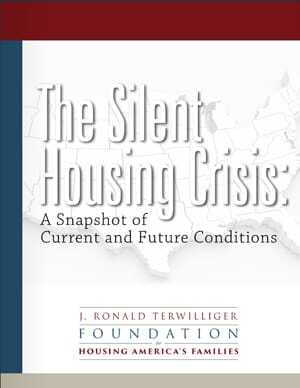The newly founded J. Ronald Terwilliger Foundation for Housing America’s Families launched in June with the release of an investigative housing report, focused on the post–Great Recession housing market in the United States. The report, titled The Silent Housing Crisis: A Snapshot of Current and Future Conditions, says that nearly six years after the official end of the Great Recession, the domestic housing system has not yet—contrary to other sectors of the economy—emerged from a state of crisis. The market continues to suffer from a lack of affordable housing options, insufficient federal subsidies budget, and the emergence of more stringent mortgage underwriting standards.
An increasing number of Americans today find themselves living in residences that exceed their means. It is estimated that more than 20 million households spend over 50 percent of their income on housing and one-third of all American households spend over 30 percent of income on housing. Stagnation of the average household income has made it difficult for families to adjust to the incommensurate contemporary housing market. On one end, rents have increased because of a growing population and a shortage of affordable housing; and on the other, the dream of homeownership remains unattainable due to higher downpayment expectations and tougher credit score requirements.
The impoverishing effects of the Great Recession and austerity that followed have forced many households to elect to rent and abandon hope of homeownership for the sake of their wallets. The JRT Foundation estimates that in the decade following the Great Recession, 2010–2019, 62 percent of housing demand will be rental.
As is the norm, the group hit hardest by this crisis are low-income households. The JRT Foundation estimates that for every 100 extremely low-income households, 29 affordable housing units exist on the market. When placed in a national context, this sum amounts to some 8 million households across the United States.
The report’s research suggests that four out of five households in this category (i.e., those making $15,000 per year or less) pay at least 30 percent of their income for housing and two out three pay over 50 percent of their income for housing. This acute shortage of affordable housing forces low-income households to sacrifice their consumption of other vital goods and services, such as health care and nutritious food. These statistics are particularly alarming when one considers that households with children are the largest group affected by severe rental cost burdens.
While this group is the most markedly affected, other demographics, including millennials, the elderly, and immigrants, also are acutely affected by this crisis. With the younger generation entering the housing market, the senior generation outliving its predecessors, and higher immigration levels, the demand for housing is becoming even greater and is pushing rent to new heights.
Between 2007 and 2011, more than 3 million foreclosed homes were converted into rental space; and postrecession, multifamily developments have significantly increased. Although this has helped alleviate demand pressures, a gap between supply and demand continues to persist. While a high demand for housing exists, there is a significant disparity between the cost of development and the price many households can afford to pay. The construction of affordable housing for low- to moderate-income households has typically been assisted by an array of various development subsidies at the federal and local levels. Yet in this period of continued fiscal austerity, budget cuts and sequestration have limited the availability of housing subsides nationwide. With little potential for profits in the absence of federal subsidies, developers in many areas have no incentive to build affordable housing.
In its conclusion, the report stresses that the need for political leadership and the reallocation of budget funds to support housing opportunities is of paramount importance to the resolution of this crisis. Changing demographics and a surging domestic population will prove to only exacerbate the unaffordability of housing in America. To tackle the “silent crisis,” new government policy must be formulated to address current needs and developing trend of the housing market. The recovery of this market is inseparably tied to the full recovery of the entire economy; and if sustainable growth is to be realized across America, the systemic issues afflicting the U.S. housing system must be addressed.





